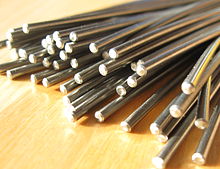Nitinol
Nitinol is a nickel - titanium - alloy and the best known representative of the shape memory alloys . The name Nitinol is an acronym for Ni ckel Ti tanium N aval O rdnance L aboratory. Nitinol was developed in 1958 at the Naval Ordnance Laboratory (USA) by William J. Buehler and Frederick Wang.
Nitinol is the NiTi intermetallic phase with an ordered-cubic crystal structure that differs from that of titanium and nickel. It consists largely of nickel (approx. 55%), another large part of titanium. The alloy can be used up to 650 ° C, is corrosion-resistant and high-strength, but can be deformed pseudo-elastically up to approx. 8% .
The transformation temperature can be influenced via the alloy ratio. Alloys with a low transformation temperature of e.g. B. 0 ° C are colloquially called super-elastic. At room temperature, super-elastic material behaves similarly to spring steel . A typical application is surgical tools, endoscopes or implants such as stents because of their great deformability and good corrosion resistance . An alloy with a high transformation temperature of e.g. B. 80 ° C is colloquially called memory metal or shape memory metal. Objects made from this alloy can be bent with little effort at room temperature. When heated above the transformation temperature, they return to their original shape. The basic shape can be embossed by annealing at approx. 500 ° C. A well-known example is the nitinol paper clip, which is used as an object of illustration but has no practical use. Typical applications are robot actuators and valves.
Nitinol is expensive because alloying has to take place under vacuum and even small amounts of impurities have a negative impact on the desired material properties. Because of its high price, nitinol is not used in mass products.
Nitinol is very tough. Wires can be cut with sturdy wire cutters. Normal side cutters or scissors are not suitable. The shaping is done by grinding or electrical discharge machining . Wires are made by pulling them through . The wire is annealed between the drawing processes.
Nitinol motor powered by a tea light
properties
- Density : 6450 kg / m³
- Melting temperature : 1240-1328 ° C
- Nitinol is non-ferromagnetic and has a lower magnetic susceptibility than stainless steel and is therefore suitable for all imaging procedures (patients with Nitinol implants and stents can therefore get an MRI).
Individual evidence
- ↑ WJ Buehler, JW Gilfrich & RC Wiley: Effects of low-temperature phase changes on the mechanical properties of alloys near TiNi composition . In: Journal of Applied Physics 34, 1963, p. 475. doi: 10.1063 / 1.1729603
- ^ FE Wang, WJ Buehler & SJ Pickart: Crystal structure and a unique martensitic transition of TiNi . In: Journal of Applied Physics 36, 1965, pp. 3232-3239. doi : 10.1063 / 1.1702955
- ↑ a b c Entry on Nitinol. In: Römpp Online . Georg Thieme Verlag, accessed on January 12, 2017.
Web links
- ODS GmbH: On the history of Nitinol ( Memento from May 29, 2013 in the Internet Archive )




